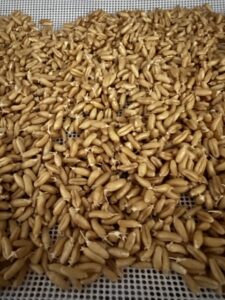
About ten years ago when I was living in the foodie mecca Portland, Oregon, I went to Bob’s Red Mill inquiring about the type of wheat berries specifically for making pasta. I was directed to Kamut . This is the trademarked name for khorasan wheat, an ancient grain variety related to Durum wheat, the wheat traditionally used to make pasta. Kamut is more easily digested than traditional wheat. Compared to regular wheat, Kamut has a significantly higher protein content (up to 40% more), more amino acids (up to 65% more) and is also richer in potassium, magnesium, selenium, zinc, and vitamin E – which have significant health benefits for the heart, bones, joints, digestion, circulation, and cognition..
Being higher in protein than regular wheat, Kamut makes a softer, yet more durable pasta, even as a 100% whole grain. It contains a different type of gluten than the gluten in modern varieties of wheat. This helps people consume it who are sensitive to the gluten in modern wheat (not those with celiac disease or severe gluten intolerances).
A Kamut grain is a seed. All the nutrition a plant needs to begin its life is stored inside its seeds – protein, starch, fat, and enzymes are in a protective case to give seeds their best shot at survival. When the grain sprouts, those enzymes activate and begin to turn the seed’s stored nutrients into more usable and digestible forms, making it more nutritious. For more details, visit https://onedegreeorganics.com/sprouted-grains-the-benefits-of-sprouting-everything-you-need-to-know/. I’ve been testing out sprouting the kamut grains for several months.
Even with extensively making pasta with the Kamut grains – both without and with sprouting the grains for a decade, it takes some finesse to make a nicely textured pasta using freshly milled whole wheat berries. Just using the Kamut – whether sprouted or not, even using the fine setting with the flour mill, the pasta is more gritty than regular pasta.
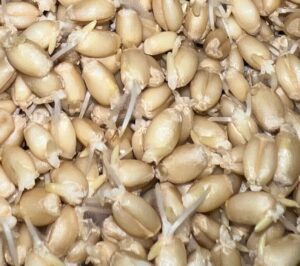 In pursuit of a less gritty, sprouted grain pasta, I researched pasta recipes. Most recipes use regular white flour. Several recipes that used “semolina” (this is the name for milled durum wheat) – mixed it with what they term “soft flour.” Soft flour is milled from low-protein strains of wheat that has less gluten. It is marketed as “cake” or “pastry” flour. Knowing this, I would mix my milled Kamut flour with commercial organic soft flours, but I wanted to make a fully sprouted grain pasta.
In pursuit of a less gritty, sprouted grain pasta, I researched pasta recipes. Most recipes use regular white flour. Several recipes that used “semolina” (this is the name for milled durum wheat) – mixed it with what they term “soft flour.” Soft flour is milled from low-protein strains of wheat that has less gluten. It is marketed as “cake” or “pastry” flour. Knowing this, I would mix my milled Kamut flour with commercial organic soft flours, but I wanted to make a fully sprouted grain pasta.
I found soft white wheat berries and set out to sprout then dehydrate those as well. Then I used equal ratios of the sprouted Kamut and Soft White Wheat berries. I tested adding in super fine soluble oat fiber for this effort, but will skip in the next time in case it contributed to my spaghetti noodles breaking.
Making Pasta Dough
I learned how to make pasta in 2009 at the Academia Barilla in Parma, Italy. It’s a very simple recipe – flour, eggs, and salt. I keep it simple by using ratios:
1 egg, 1/2 cup flour, 1/4 tsp salt – makes two servings of pasta (no leftovers). Since I like leftovers, I use that ratio per serving. For this experiment, I used 2 eggs, 1/2 cup sprouted Kamut, 1/2 cup sprouted soft white wheat, and 1/2 tsp salt. Plus put in 2 tbs soluble oat fiber (and added in 1 tbs water). My thinking was this could smooth out any residual grittiness from milling the whole berries.
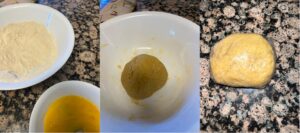
If you’ve watched any shows where they are making home made pasta, they often put the flour right on the counter, make a well in the middle and toss the eggs in there. Then mix it all up with their hands. I’m not a fan of that approach. First, there is a lot of stuff that goes on my counter and while I do clean it after every use, I’m not comfortable mixing food right on my counter (especially with the cleaning supplies used to keep the counter sanitary). Second, it seems to create a supreme mess for no added value in flavor or result. So I use a shallow wide bowl and first mix the egg and flour together with a fork, then knead it into a ball with my hands (it is often a little bit sticky but if it’s too sticky, add in more soft flour). What I learned in Italy was to do what makes the most sense for my preferences.
Once the egg is all mixed in with the flour, a very important step is to cover the pasta dough ball with saran wrap and let it rest for several hours (this gives the flour even more time to absorb the moisture from the egg).
Making Pasta
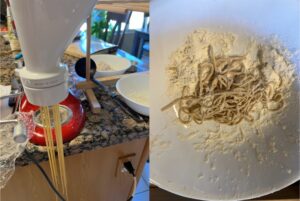
I used to only use a pasta roller to make pasta, but several months ago, I wanted to experiment with extruding pasta dough so I got an extruding attachment for my kitchen aid. I’ve had fun making different types of noodles with it – but have generally had less than optimal results with longer pastas like bucatini and spaghetti. So this extruder probably was not the best tool for me to use with this effort. Luckily I made a small batch and can try again soon.
When using the extruder, I cut the dough into walnut sized portions and rolled it in white flour to reduce stickiness. The smaller pieces are stuffed into the extruder pushing it out into spaghetti. Cutting it out of the extruder, I tossed it in a bowl with more flour to keep it separated. The dough was overall not conditioned or strong enough for this and ended up breaking before it could be hung on the pasta drying rack.
Using the Pasta
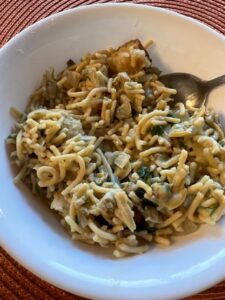
Since I had planned on using the sprouted grain spaghetti in a clam sauce that called for it to be cooked for a very brief time in the salted pasta water, then complete cooking it in the clam broth, I thought it was fine in the smaller sections, so continued. Once the home made spaghetti reached the right texture in the clam sauce, I finished the dish with a robust red cow parmesan, sour dough croutons, and fresh lemon juice from a lemon picked earlier in the day off our backyard lemon tree.
The taste and the texture was on the mark for the sprouted grain spaghetti. If I was making a chicken noodle soup, the broken spaghetti noodles would’ve been perfect. The sprouted grain flavor worked with the brininess of the clam sauce – complementary – neither overpowered the other. Even though I consider this a “fail” for the structural integrity of the spaghetti, the overall meal was delicious!
Next time, I’m going to make sprouted grain linguini with the pasta rollers……

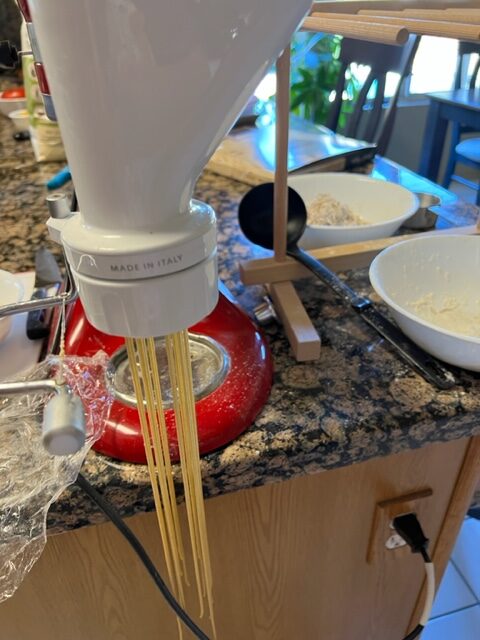
Comments